| Article ID | Journal | Published Year | Pages | File Type |
|---|---|---|---|---|
| 9573543 | Biophysical Chemistry | 2005 | 15 Pages |
Abstract
Torsion elastic constants obtained from fluorescence polarization anisotropy (FPA) measurements on fifty-three 24 and 27 base-pair (bp) DNAs were recently reported [1], [2] [F. Pedone, F. Mazzei, D. Santoni, Sequence-dependent DNA torsional rigidity: a tetranucleotide code, Biophys. Chem. 112 (2004) 77-88; F. Pedone, F. Mazzei, M. Matzeu, F. Barone, Torsional constant of 27-mer DNA oligomers of different sequences, Biophys. Chem. 94 (2001) 175-184]. The problem of extracting reliable torsion elastic constants (α) from FPA measurements on such short DNAs is examined in detail. The difficulty is illustrated by two (fictitious) 24 bp DNAs with â¼5-fold different torsion elastic constants and 10% different initial anisotropies (r0), which exhibit practically indistinguishable anisotropy decays for all t>1 ns. FPA data were simulated for 24 bp DNAs with different input values of α and r0 in the presence and absence of Poisson noise, and were fitted using different choices of the adjustable and fixed parameters. Experimental data for a 24 bp DNA were fitted in a similar manner. For either the simulated or experimental FPA data, it was not possible to determine both the initial anisotropy, r0, and the torsion elastic constant, α, in a reliable (i.e. statistically significant) manner in the presence of Poisson noise. When r0 is assumed to be fixed at any particular value in the fitting protocol, a unique best-fit value of α is obtained, but that best-fit α is extremely sensitive to small deviations of the assumed fixed value of r0 away from the input r0-value of the simulated data. Pedone et al. fitted their FPA data by assuming that r0=0.360, and adjusting α, the hydrodynamic radius (RH), and effective length (L). In fact, the reported best-fit values of RH and L lay significantly outside their expected ranges. When this same fitting protocol is applied to simulated data for 27 bp DNAs, better overall agreement with the reported experimental values (α, RH, and L) is obtained for a model, wherein all DNAs have the same typical input α=5.9Ã10â12 dyn cm, RH=10.0 Ã
, and L=27 (3.4)+2.7=94.5 Ã
, but a 1.00- to 1.13-fold range of r0-values, than for the model of Pedone et al., wherein all DNAs have the same input r0=0.360, RH=10.0 Ã
, and L=94.5 Ã
, but a â¼3-fold range of α-values. It is concluded that, in the absence of reliable independent estimates of r0 for every DNA, the α-values reported for 24 and 27 bp DNAs cannot be regarded as experimentally justified. The reliability of the torsion elastic constants reported for the 136 distinct tetranucleotide steps, which are inferred from the values reported for the fifty-three 24 and 27 bp DNAs, is also briefly discussed.
Related Topics
Physical Sciences and Engineering
Chemistry
Physical and Theoretical Chemistry
Authors
Bryant S. Fujimoto, J. Michael Schurr,
